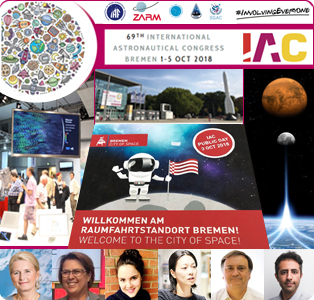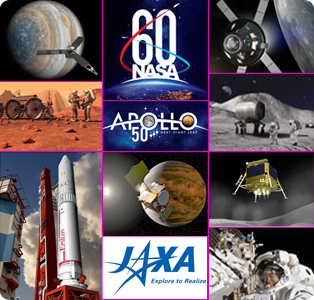International Astronautical Congress 2018 Meets in Bremen, Commencing World Space Week
International Astronautical Federation (IAF) holds the 69th IAC in Bremen, Germany on October 1-5 with the theme “Involving Everyone”, locally organized by Center of Applied Space Technology and Microgravity (ZARM). Co-organizers include the International Academy of Astronautics, International Institute of Space Law, and Space Generation Advisory Council (SGAC). This year’s IAC boasts a record number of 2,500+ presenters from 90 countries. The plenary on Tuesday will discuss “Joint Future in Space”, featuring a panel of women including DLR chair Pascale Ehrenfreund and UNOOSA Director Simonetta di Pippo. IAF is hosting 3G Diversity sessions to foster diversity across Geography, Generation, and Gender. SGAC led by Clementine Decoopman was the winner of this year’s 3G Diversity Award. Mika Ochiai of JAXA is presenting on International Space Exploration Forum for Young Professionals, while Peter Martinez of South Africa is presenting on space sustainability. Two scientists from Universiti Teknologi MARA in Malaysia are presenting in Space Astronomy session. There are three Moon Exploration sessions, with Takeshi Hoshino of JAXA presenting on lunar polar exploration, in addition to ISRO, ispace, SpaceIL, Canadensys, ILOA, and many others. Finally, this IAC hosts many interactive sessions with over 30 interactive presentations focused on the Moon, including Zaid Rana of SGAC discussing lunar radio telescope array, 7 China participants discussing Moon missions, and 6 participants from ispace, JAXA, and Japan Manned Space Systems Corporation. (Image Credits: IAF, UNOP, IAF, IAA, IISL, SGAC, ESA) |
MONDAY Highlights…
|

![]() = All times
= All times
for terrestrial events in local time unless noted.
![]() = All times for international terrestrial events in local time unless noted.
= All times for international terrestrial events in local time unless noted.
![]() = All times for space events, and…
= All times for space events, and…
![]() = All times for international space / astro events in Hawaii Standard Time unless noted. Add 10 hours to obtain UT (‘Universal Time’).
= All times for international space / astro events in Hawaii Standard Time unless noted. Add 10 hours to obtain UT (‘Universal Time’).
Weekly Planet Watch – Evening Planets: Venus (WSW), Mars (S), Jupiter (SW), Saturn (S), Uranus (E), Neptune (SE).
NASA@60 and JAXA@15: Human Spaceflight, Lunar and Deep-Space Focus
|
Continued from…
|
TUESDAY
![]() Oct 2 — American Institute of Aeronautics and Astronautics, National Academy of Engineering, Washington DC: Yvonne Brill Lecture: Student Design-Build-Fly Micro and Nano-Satellites; by Helen Reed, Regents Professor at Texas A&M University in College Station.
Oct 2 — American Institute of Aeronautics and Astronautics, National Academy of Engineering, Washington DC: Yvonne Brill Lecture: Student Design-Build-Fly Micro and Nano-Satellites; by Helen Reed, Regents Professor at Texas A&M University in College Station.
![]() Oct 2 — Moon: 11.2° S of Castor, 21:00.
Oct 2 — Moon: 11.2° S of Castor, 21:00.
WEDNESDAY
![]() Oct 3 — Hayabusa2, Asteroid 1999 JU3: JAXA Hayabusa2 landing probe provided by Germany and France set to be released today.
Oct 3 — Hayabusa2, Asteroid 1999 JU3: JAXA Hayabusa2 landing probe provided by Germany and France set to be released today.
![]() Oct 3 — Parker Solar Probe, 1st Venus Flyby: The 1st of 7 Venus gravity assist flybys planned for Parker Solar Probe, helping to shrink its orbit around the Sun to come within 6.16M km of the Sun, well within the orbit of Mercury and ~7 times closer than any spacecraft has before.
Oct 3 — Parker Solar Probe, 1st Venus Flyby: The 1st of 7 Venus gravity assist flybys planned for Parker Solar Probe, helping to shrink its orbit around the Sun to come within 6.16M km of the Sun, well within the orbit of Mercury and ~7 times closer than any spacecraft has before.
![]() Oct 3 — International Astronautical Federation, ZARM, IAA, SGAC, IISL, Bremen, Germany: IAF IDEA Geography, Generation, Gender “3G” Diversity Day; morning and afternoon sessions featuring IAF President Jean-Yves Le Gall, DLR Chair Pascale Ehrenfreund, JAXA President Hiroshi Yamakawa, Moderator Mary Snitch, Danielle Richey of Lockheed Martin.
Oct 3 — International Astronautical Federation, ZARM, IAA, SGAC, IISL, Bremen, Germany: IAF IDEA Geography, Generation, Gender “3G” Diversity Day; morning and afternoon sessions featuring IAF President Jean-Yves Le Gall, DLR Chair Pascale Ehrenfreund, JAXA President Hiroshi Yamakawa, Moderator Mary Snitch, Danielle Richey of Lockheed Martin.
![]() Oct 3 — Aura, Division for Planetary Science of the American Astronomical Society, Knoxville TN: Women in Planetary Science Discussion Hour advocating the support of women in STEM.
Oct 3 — Aura, Division for Planetary Science of the American Astronomical Society, Knoxville TN: Women in Planetary Science Discussion Hour advocating the support of women in STEM.
![]() Oct 3 — Moon: 7.5° S of Pollux, 01:00.
Oct 3 — Moon: 7.5° S of Pollux, 01:00.
![]() Oct 3 — Amor Asteroid 2018 RS1: Near-Earth Flyby (0.054 AU)
Oct 3 — Amor Asteroid 2018 RS1: Near-Earth Flyby (0.054 AU)
![]() Oct 3 — Amor Asteroid 2009 TK: Near-Earth Flyby (0.073 AU)
Oct 3 — Amor Asteroid 2009 TK: Near-Earth Flyby (0.073 AU)
THURSDAY
![]() Oct 4 — ISS, Soyuz MS-08 Undocking & Landing, 405-km LEO: Expedition 56 members Artemyev, Feustel, Arnold to return to Earth landing near Dzhezkazgan, Kazakhstan.
Oct 4 — ISS, Soyuz MS-08 Undocking & Landing, 405-km LEO: Expedition 56 members Artemyev, Feustel, Arnold to return to Earth landing near Dzhezkazgan, Kazakhstan.
![]() Oct 4-10 — World Space Week Association, Global: World Space Week 2018; to celebrate international contributions of space science and technology to the betterment of the human condition; Oct 4 is 61st observation of 1st Space mission Sputnik One launched by Soviet Union 1957; Oct 10 is 51st observation of Outer Space Treaty going into effect 1967.
Oct 4-10 — World Space Week Association, Global: World Space Week 2018; to celebrate international contributions of space science and technology to the betterment of the human condition; Oct 4 is 61st observation of 1st Space mission Sputnik One launched by Soviet Union 1957; Oct 10 is 51st observation of Outer Space Treaty going into effect 1967.
![]() Oct 4 — Moon: 0.94° SSW of Beehive Cluster, 00:00.
Oct 4 — Moon: 0.94° SSW of Beehive Cluster, 00:00.
![]() Oct 4 — Apollo Asteroid 2018 SP1: Near-Earth Flyby (0.039 AU)
Oct 4 — Apollo Asteroid 2018 SP1: Near-Earth Flyby (0.039 AU)
FRIDAY
![]() Oct 5 — Canada-France-Hawaii Telescope, Kamuela HI: CFHT opens doors to students for 3 individual tours of machine shop and electrics lab on ‘National Manufacturing Day’.
Oct 5 — Canada-France-Hawaii Telescope, Kamuela HI: CFHT opens doors to students for 3 individual tours of machine shop and electrics lab on ‘National Manufacturing Day’.
![]() Oct 5 — British Interplanetary Society, Bath, United Kingdom: Lecture: Beagle 2 – Lost on Mars but Found 11 Years Later.
Oct 5 — British Interplanetary Society, Bath, United Kingdom: Lecture: Beagle 2 – Lost on Mars but Found 11 Years Later.
![]() Oct 5-6 — American Astronomical Society, Mount Holyoke, MA Space Grant Consortium, et al, Wellesley MA: Maria Mitchell Women in Science Symposium.
Oct 5-6 — American Astronomical Society, Mount Holyoke, MA Space Grant Consortium, et al, Wellesley MA: Maria Mitchell Women in Science Symposium.
![]() Oct 5 — Moon: at perigee (distance 366,013.95 km), 12:31; 1.8° NNE of Regulus, 13:00.
Oct 5 — Moon: at perigee (distance 366,013.95 km), 12:31; 1.8° NNE of Regulus, 13:00.
![]() Oct 5 — Mercury: 2.0° NNE of Spica, 23:00.
Oct 5 — Mercury: 2.0° NNE of Spica, 23:00.
![]() Oct 5 — Amor Asteroid 2018 RZ1: Near-Earth Flyby (0.100 AU)
Oct 5 — Amor Asteroid 2018 RZ1: Near-Earth Flyby (0.100 AU)
SATURDAY
![]() Oct 6 — SpaceX, Launch Falcon 9 / SAOCOM 1A, SLC-4E, Vandenberg AFB CA: SpaceX Falcon 9 rocket set to launch Earth observation satellite SAOCOM 1A for Argentina Space Agency (CONAE).
Oct 6 — SpaceX, Launch Falcon 9 / SAOCOM 1A, SLC-4E, Vandenberg AFB CA: SpaceX Falcon 9 rocket set to launch Earth observation satellite SAOCOM 1A for Argentina Space Agency (CONAE).
![]() Oct 6 — Kona-Kohala Chamber of Commerce, Canada-France Telescope, Office of Maunakea Management, TMT International Observatory, W. M. Keck Observatory, Hawaii Electric Light Co., Kailua-Kona HI: AstroDay Kona 2018; 11:00-15:00.
Oct 6 — Kona-Kohala Chamber of Commerce, Canada-France Telescope, Office of Maunakea Management, TMT International Observatory, W. M. Keck Observatory, Hawaii Electric Light Co., Kailua-Kona HI: AstroDay Kona 2018; 11:00-15:00.
![]() Oct 6 — AIAA San Francisco Section, Lick Observatory, Mt Hamilton CA: Lick Observatory Tour; 17:00-20:00, US$25-30.
Oct 6 — AIAA San Francisco Section, Lick Observatory, Mt Hamilton CA: Lick Observatory Tour; 17:00-20:00, US$25-30.
![]() Oct 6-11 — World Meteorological Organization, Indonesia Agency for Meteorology Climatology and Geophysics (BMKG), Secure World Foundation, Jakarta, Indonesia: 9th Asia/Oceania Meteorological Satellite Users’ Conference.
Oct 6-11 — World Meteorological Organization, Indonesia Agency for Meteorology Climatology and Geophysics (BMKG), Secure World Foundation, Jakarta, Indonesia: 9th Asia/Oceania Meteorological Satellite Users’ Conference.
![]() Oct 6-14 — Solar System Exploration Research Institute, Flagstaff & Meteor Crater AZ: 5th Field Training and Research Program.
Oct 6-14 — Solar System Exploration Research Institute, Flagstaff & Meteor Crater AZ: 5th Field Training and Research Program.
SUNDAY
![]() Oct 7-14 — Special Astrophysical Observatory of the Russian Academy of Science, Baksan Neutrino Observatory of Institute for Nuclear Research, Nizhnij Arkhyz and Terskol, Russia: Conference: The Multi-Messenger Astronomy – Gamma-Ray Bursts, Search for Electromagnetic Counterparts to Neutrino Events and Gravitational Waves.
Oct 7-14 — Special Astrophysical Observatory of the Russian Academy of Science, Baksan Neutrino Observatory of Institute for Nuclear Research, Nizhnij Arkhyz and Terskol, Russia: Conference: The Multi-Messenger Astronomy – Gamma-Ray Bursts, Search for Electromagnetic Counterparts to Neutrino Events and Gravitational Waves.
![]() Oct 7 — Apollo Asteroid 2006 HE2: Near-Earth Flyby (0.096 AU)
Oct 7 — Apollo Asteroid 2006 HE2: Near-Earth Flyby (0.096 AU)

